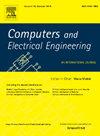A new parallel PQDs classification method based on an optimized NLM and an improved DRSN-TCN model
IF 4
3区 计算机科学
Q1 COMPUTER SCIENCE, HARDWARE & ARCHITECTURE
引用次数: 0
Abstract
Considering the multidimensional characteristics of single and composite Power Quality Disturbances (PQDs), this article proposes a new parallel PQDs classification method based on an optimized NLM and an improved DRSN-TCN model. The method effectively solves the problems of high computational complexity, overfitting, and gradient explosion in existing serial method. Meanwhile, it could restrain the interference of noise on the inherent characteristics of PQDs in actual power grids, effectively extracts PQDs features, and thus improves classification accuracy, with strong noise robustness and generalization ability. Firstly, an optimized non-local means (NLM) denoising method is employed to process the noisy PQDs signals. The Greater cane rat algorithm (GCRA) is utilized to adaptively determine the optimal parameters for NLM. By estimating and performing weighted averaging for each sample point in the noisy signal, the method effectively preserves signal detail features, thereby achieving an accurate reconstruction of the original signal. Secondly, to overcome the poor anti-noise capability of the Deep Residual Shrinkage Network (DRSN) model, a new threshold function is proposed to replace the original soft threshold function, enhancing its anti-noise interference capability; to address the issue of the Temporal Convolutional Network (TCN) model's complex structure leading to prolonged training times, a reverse TCN structure is proposed. This structure decreases the receptive field layer by layer as the network depth increases, reducing training parameters and improving training efficiency. Finally, the high-dimensional PQDs features extracted from DRSN and TCN are fed into a feature fusion module for classification. To verify the effectiveness of this method, a parallel classification model is built based on the PyTorch framework, and simulation and comparative experiments on single and composite PQDs are conducted. The results show that the proposed method can effectively classify PQDs, under no noise, 40 dB, 30 dB, and 20 dB noise conditions, the classification accuracies for 16 types of single and composite PQDs are 99.34 %, 98.89 %, 98.12 %, and 96.28 %, respectively, demonstrating the model's strong noise robustness and generalization capability. To further validate the superiority of this method, comparative experiments were conducted among the proposed model and other models such as EWT+SVM, CNN, CNN-LSTM, Transformer, TCN, and DRSN. The results indicate that the improved DRSN-TCN model converges smoothly without oscillation and achieves better classification accuracy. Therefore, the proposed model demonstrates certain advantages over other models.
基于优化NLM和改进DRSN-TCN模型的并行pqd分类新方法
针对单一和复合电能质量扰动的多维特性,提出了一种基于优化NLM和改进DRSN-TCN模型的并行电能质量扰动分类方法。该方法有效地解决了现有序列方法计算复杂度高、过拟合和梯度爆炸等问题。同时,能够抑制噪声对实际电网中pqd固有特征的干扰,有效提取pqd特征,从而提高分类精度,具有较强的噪声鲁棒性和泛化能力。首先,采用优化的非局部均值(NLM)去噪方法对带噪声的PQDs信号进行处理。采用大蔗鼠算法(GCRA)自适应确定NLM最优参数。该方法通过对噪声信号中的每个采样点进行估计和加权平均,有效地保留了信号的细节特征,从而实现了对原始信号的精确重构。其次,针对深度残余收缩网络(Deep Residual Shrinkage Network, DRSN)模型抗噪声能力差的问题,提出了一种新的阈值函数来取代原有的软阈值函数,增强了其抗噪声干扰能力;针对时间卷积网络模型结构复杂导致训练时间延长的问题,提出了一种反向的时间卷积网络结构。这种结构随着网络深度的增加逐层递减接受野,减少了训练参数,提高了训练效率。最后,将从DRSN和TCN中提取的高维pqd特征输入到特征融合模块中进行分类。为了验证该方法的有效性,基于PyTorch框架建立了并行分类模型,并在单pqd和复合pqd上进行了仿真和对比实验。结果表明,该方法能够有效地对pqd进行分类,在无噪声、40 dB、30 dB和20 dB噪声条件下,对16种单pqd和复合pqd的分类准确率分别为99.34%、98.89%、98.12%和96.28%,表明该模型具有较强的噪声鲁棒性和泛化能力。为了进一步验证该方法的优越性,将本文提出的模型与EWT+SVM、CNN、CNN- lstm、Transformer、TCN、DRSN等模型进行了对比实验。结果表明,改进后的DRSN-TCN模型收敛平稳,无振荡,具有较好的分类精度。因此,该模型与其他模型相比具有一定的优势。
本文章由计算机程序翻译,如有差异,请以英文原文为准。
求助全文
约1分钟内获得全文
求助全文
来源期刊

Computers & Electrical Engineering
工程技术-工程:电子与电气
CiteScore
9.20
自引率
7.00%
发文量
661
审稿时长
47 days
期刊介绍:
The impact of computers has nowhere been more revolutionary than in electrical engineering. The design, analysis, and operation of electrical and electronic systems are now dominated by computers, a transformation that has been motivated by the natural ease of interface between computers and electrical systems, and the promise of spectacular improvements in speed and efficiency.
Published since 1973, Computers & Electrical Engineering provides rapid publication of topical research into the integration of computer technology and computational techniques with electrical and electronic systems. The journal publishes papers featuring novel implementations of computers and computational techniques in areas like signal and image processing, high-performance computing, parallel processing, and communications. Special attention will be paid to papers describing innovative architectures, algorithms, and software tools.
 求助内容:
求助内容: 应助结果提醒方式:
应助结果提醒方式:


